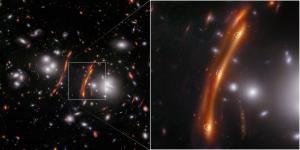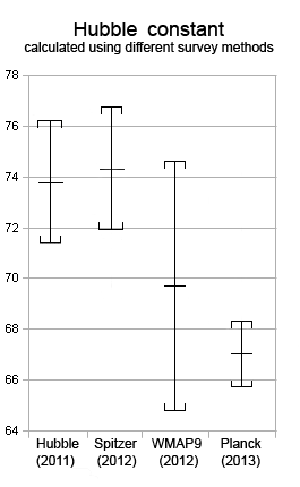Blog
Tension and H0pe
3 October 2024
 NASA, ESA, CSA, STScI
NASA, ESA, CSA, STScIWe’ve known the Universe is expanding for a long time. The first solid paper demonstrating cosmic expansion was published by Edwin Hubble in 1929, based on observations made by Vesto Slipher, Milton Humason, and Henrietta Leavitt. Because of this, the rate of cosmic expansion is known as the Hubble constant, or Hubble parameter, H0. From this parameter, you can calculate things such as the age of the Universe since the Big Bang, so knowing the value of H0 is central to our understanding of modern cosmology.
Early on, the measured value of the Hubble parameter varied widely. Hubble’s initial value was on the order of 500 (km/s)/Mpc. By the 1960s, the value settled down to between 50 and 90 (km/s)/Mpc, where it stayed for most of the 20th century. It was difficult to get more precise because our methods of calculating it were limited. All of these were based on the cosmic distance ladder, which uses a series of observations to calculate ever greater cosmic distances, each building on the previous method. But in the past few decades we got pretty good at it, and the Hubble value seemed to settle around 70 (km/s)/Mpc. After that, things started to get…problematic.
 Wikipedia user Primefac
Wikipedia user PrimefacWith satellites such as WMAP and Planck we started to get high-resolution maps of the cosmic microwave background. From fluctuations in this background we have a new way to measure H0 and get a value of 67 - 68 (km/s)/Mpc. At the same time, observations of distant supernovae and the cosmic distance ladder pin down the value to 73 - 75 (km/s)/Mpc. Both methods are quite precise, and yet they entirely disagree. This disagreement is now known as the Hubble tension problem, and it is the most bothersome mystery in cosmology.
We aren’t sure what causes the Hubble tension. It might mean that one or more of our observation methods are fundamentally flawed, or it might mean there is something about dark energy and cosmic expansion that we really don’t understand. But astronomers generally agree that one way to address this mystery is to look for ways to measure H0 that are independent of both the cosmic background and the cosmic distance ladder. One such method involves gravitational lensing.
Gravitational lensing occurs because gravity warps space, meaning that the path of light can be deflected by the presence of a large mass. So, for example, if a distant galaxy happens to be behind a closer galaxy from our vantage point, we see a gravitationally distorted view of the distant galaxy or even multiple images of the galaxy. The interesting thing about the multiple image effect is that the light from each image travels a different path around the closer galaxy, each with a different distance. Since the speed of light is finite this means each image gives us a view of the galaxy at different times in history.
This doesn’t matter much for galaxies, but for supernovae it means gravitational lensing can let us observe the same supernova multiple times. By calculating the path of each supernova image we can determine the relative distance of each path, and by timing the appearance of each image we can determine the actual distance. This gives us a measurement that is independent of the cosmic distance ladder, giving us a new way to measure the Hubble parameter. This method has been used a couple of times, but the uncertainties of their Hubble values weren’t small enough to address the Hubble tension. However, a new study using this method is precise enough.1
The study is based on JWST images of a Type Ia supernova named SN H0pe. It is one of the most distant supernovae ever observed, and thanks to the less-distant galaxy cluster G165, the team captured three lensed images of SN H0pe. With their timing, observed brightness, and calculated paths, the team calculated H0 to be 70 - 83 (km/s)/Mpc. This still has a higher uncertainty than other methods, but it agrees with the usual distance ladder method. It also clearly disagrees with the cosmic microwave background method.
Despite H0pe, the Hubble tension is very real. If anything, this new result makes the issue even more troublesome. There is something about cosmic expansion we don’t understand, and it’s now clear that better observations will not solve this mystery on their own.
Pascale, Massimo, et al. “SN H0pe: The First Measurement of H0 from a Multiply-Imaged Type Ia Supernova, Discovered by JWST.” arXiv preprint arXiv:2403.18902 (2024). ↩︎